#Musrara Mix
Explore tagged Tumblr posts
Text
Francisco Lopez talk at Musrara Mix Festival 23, Jerusalem. Part 2
www.franciscolopez.net/ t-hs.bandcamp.com/
2 notes
·
View notes
Photo
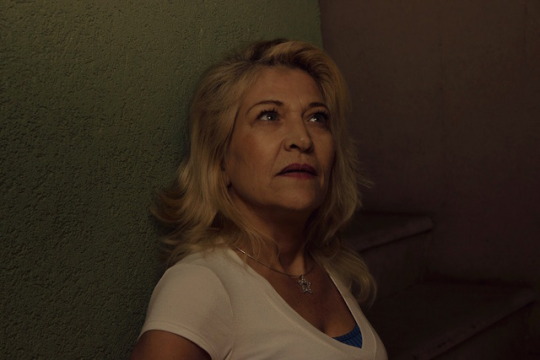
Focusing a New Lens on Mizrahiness
“Generation(s) of Levantines” by Leeor Ohayon
view the accompanying documentary photography series following the essay
“What exactly are you trying to capture? Which community? There just isn’t such a thing as Mizrahi,” my interviewee told me shortly. He had a point; what on earth was I trying to document?
Being of mixed Moroccan and Adeni heritage and having attended Jewish schools in London all my life, I became very much aware of the erasure of Mizrahi and Sephardic Judaism in the public realm. Jewish studies at school were conducted around an Ashkenazi-centric reading of history that began in Warsaw and ended with the Khurva synagogue in Jerusalem. Israeli Independence Day was celebrated with Klezmer music in the auditorium and dry falafel for lunch.
Mizrahi histories and cultures have been sacrificed at the altar of a collective Jewish imagination. That is to say-- our understanding of Judaism and Jewish memory is always conducted through the Ashkenazi experience, by Jews and non-Jews alike. The Ashkenazi label has become the default face of Judaism and Jewishness, and consequently is often found interchangeably replaced with just “Jewish.” Non-Ashkenazi cultures, in comparison, are hyphenated, asterisked, and put in boxes-- if not shelved entirely.
Perhaps that’s why heading to Israel to document Mizrahim proved to be my own Mizrahi education. I was confronted by the fact that my understanding, despite seeing myself as well versed in Mizrahi history, was coloured by my experience as a Mizrahi in the UK. Ashkenormativity alienates Mizrahim everywhere, but in Israel there is an entire political and social commentary surrounding this subject that often feels absent in the West.
When my interviewee asserted to me that there’s no such thing as “Mizrahi,” he was technically right. Mizrahiness is what professor Ella Shohat referred to as an “imagined community” borne of interactions with Ashkenazi Israel that ethnicised Mizrahi Jews.
So vast is the cultural, linguistic and geographic space that Mizrahi groups occupy that no single aspect could be said to be the unifying factor between them. Neither as followers of the Sephardic rite - Yemenite Jewry proving an exception to that - nor as hailing from a geographic East – for example in the case of North African Jews - and neither in a common lingua franca, like Yiddish for Ashkenazi Jewry.
Rather its formation merely owes itself to the fact that as Jews hailing from Islamic majority places, they endured a shared destiny as non-Ashkenazi Jews in an Ashkenazi state. They went from simply being Jews in their countries of origin to being Mizrahim in Israel.
There are many things to consider while photographing a subject as vast as Mizrahi identity. I had to account for the variation within it in my work, so I held many interviews across the country, with Mizrahim of all stars and stripes and all walks of life, in an attempt to better understand how to capture Mizrahiness.
When I asked my interviewees to point me towards what they considered as Mizrahi, I was told repeatedly to “go to the periphery”. The simple reason being that in the Israeli “periphery-” the localities of the north and south historical “frontiers” that lay outside the economically prosperous stretch of Israel’s central belt cities, I was to find “authentic” Mizrahiness like it “used to be.” Supposedly, unlike the residents of the Gush Dan metropolitan area, the inhabitants of this stretch of land were not altered by “modernity”.
In this assertion, the interviewees implied (perhaps unconsciously) that Mizrahi traditions and modernity could not be reconciled. The subtext was that to be “authentically” Mizrahi meant to exist outside of modern society. Aside from the fact that the quest for cultural authenticity is futile, many had used the same orientalist tropes that have historically been used to reduce Mizrahim to exotic folklore at odds with modernity.
Such a notion is as old as Zionism itself, which initially relegated historic Mizrahi and Sephardi communities in Eretz Yisrael outside of an Ashkenazi reading of history. A Jewish “return” to a “land without a people” was fundamentally an Ashkenazi return that refused to recognise that a society of Jews and non-Jews alike already existed in historic Palestine.
Likewise, the Ashkenazi establishment belief that Mizrahim were “primitive” and “backward” ultimately led to the disastrous housing policies of the 1950s and 1960s that forcibly placed Mizrahim across volatile front-line borders and empty desert expanses, on the basis that their supposed naturally “primitive state” could withstand living in such harsh conditions without modern comforts and standards.
Those spaces that Mizrahim settled in became the Israeli periphery of today, which remains etched into the minds of many, including those I interviewed, as spaces outside of modernity.
And yet there is something to be said for the “periphery” as a space that has protected Mizrahi identities and cultures. Particularly when the outskirts of Ashkenazi population centres are also taken into consideration- for instance, Tel Aviv’s southern districts or Jerusalem’s Musrara and Katamonim neighborhoods. These Mizrahi-majority areas served as incubators of a new ethnoreligious identity in Israel.
Mizrahi settlement in the ma’abarot (transit camps) and then in the moshavim (agricultural communes) and development towns that replaced them resulted in historic cultural and societal upheavals.
A break from the Mizrahi past in the diaspora was signaled on two levels, firstly, in Mizrahi settlers’ interactions with their new co-inhabitants that hailed from across the Muslim world; and secondly, in their interactions with the structures of Israel’s Ashkenazi-dominated bureaucracy- through its education system, the military, the employment service and so forth. These interactions took place against the backdrop of Mizrahi isolation from their countries of origin, given the lack of diplomatic ties between Israel and many Islamic and Arab states. The result of this discord is that successive generations of Mizrahim have been raised in a reality where their cultures have gone from being part of a two-millennia-old conversation with the broader region they inhabited to being relegated to the private spheres of home and synagogue within a culturally ‘western’ society.
It is precisely within these interactions with the state and against this backdrop of isolation that a new Mizrahi identity had begun to form on the margins of Israeli society. The subsequent result was an intra-Mizrahi conversation that has resulted in everything from a political consciousness to the birth of Mizrahit - a musical genre rooted in the experience of Mizrahi Jews in Israel.
One of the most apparent symbols of this cultural development is the modern Mizrahi attitude toward pre-wedding henna ceremonies: rituals that many interviewees had told me to avoid capturing for its lack of “authenticity” and as a worn cliché of Mizrahiness.
I shadowed henna planners and tagged along with them to wedding halls and synagogue basements across the country. Each time, I was greeted to a scene that evoked equal feelings of dismay and fascination. Hennas were conducted according to Moroccan cookie-cutter templates regardless of whether the participants were actually Moroccan or not.
I was told that the general gravitation toward the Moroccan tradition arose from the “fun costumes” and “lively atmosphere.” As the second largest Jewish ethnic group in Israel, Moroccans undoubtedly have left their mark on the nation’s collective cultural imagination. But the Moroccan way is also attractive, as one event planner pointed out to me, because many families want to host a henna ceremony but simply don’t know where to begin, as so many traditions were lost in the course of immigration and assimilation into Israeli society.
The modern resurgence of the henna ceremony owes itself to a growing movement of Mizrahi expression in Israel -- one that is increasingly vocal and unabashedly shameless. Yet it still reflects the literal Hebrew meaning of the word mizrah (east). It’s as though Mizrahiness is precisely just that - a smorgasbord of the East.
I witnessed a Moroccan-Yemeni couple split their ceremony in half allocating equal time to conduct a Moroccan henna and the Yemeni equivalent, a za’afa. I saw an Ashkenazi mother-in-law sitting in Moroccan dress at her Persian soon-to-be daughter-in-law’s henna, while the Persian grandmother sang in Farsi to the mixed crowd. I directed and photographed a henna photo shoot for a wedding magazine with sexed-up traditional dress. I witnessed things that can only be called pan-Mizrahi.
The act of carrying out a henna is perhaps one of the greatest testimonies to the perseverance of Mizrahi cultures and the simultaneous formation of something new. Hennas today pay tribute to a diasporic past that Israel’s founding fathers wanted forgotten in their quest for a Jewish Israeli national consciousness; they boldly pine for a different, newer Israeli identity, one better rooted in its geocultural neighbourhood.
In many ways, that pan-Mizrahi conversation is the closest resemblance to the vision of the unsung essayist, Jacqueline Kahanoff. Kahanoff was a French-educated Egyptian writer of Jewish Iraqi and Tunisian descent who proudly declared herself a Levantine when Israeli statesmen warned of the social and cultural “perils” that such an assertion could bring to Israeli society. In her essays, Kahanoff asserted that Israel should do its best to view waves of Jewish migration as an opportunity to formulate a new Levantine identity- one that emphasised integration with the region’s Arab communities. She named her philosophy Levantinism, and it is for her series of essays outlining this vision that this project is named.
While Kahanoff’s ideal has not necessarily come to fruition in Israel, a form of Levantinism has arguably manifested amongst Mizrahim.
On my journey, I also headed to a number of Israel’s heritage centres; small memorial-like independent museums that preserve the memory and traditions of Jewish communities from Aden to Kochi. A forty-minute bus ride from Tel Aviv takes you to the town of Or Yehuda, where both the Libyan Heritage Centre and the Babylonian Heritage Centre for Iraqis are found, separated only by a small stretch of road. The former, unlike the latter, is more austere and modest in appearance, but both heritage centres make an avid point of retrofitting Libyan and Iraqi Jewish histories within the Zionist narrative. Both heritage centres emphasised Jewish persecution under Arab Muslim rule and Mizrahi loyalty to the Zionist movement.
I was given a tour around the Libyan Heritage Centre by a guide who spoke of her own family’s suffering in the overlooked Libyan Holocaust. Few are aware that Libya, under Italian colonial rule, hosted the Giado concentration camp in which 562 Jews perished.
My guide relayed a real sense of frustration at Israeli society’s marginalisation of the Holocaust chapters that affected Jews in North Africa and the Balkans. “Why? Because we didn’t lose enough people?” she asked me.
Recognition of the Holocaust that blighted the Libyan community is a historical wrong that needs addressing. Its prevalence today is reflected in the fact that, in Israel, Holocaust remembrance has all the trappings of a civic religion. The memory of the Holocaust and the narrative of the Ashkenazi Zionist “pioneer” were core facets of Israeli identity building and the development of a collective national memory, and it is precisely due to the centrality of both such narratives in the Israeli national pantheon (at the expense of others) that Mizrahim have long felt shut out.
In the heritage center, as we toured countless rooms of wax figures clothed in regional Libyan dress, my guide reiterated the fundamental contribution of Libyan Jews to the Zionist movement, stopping by a series of black and white photographs to discuss Libyan involvement with Zionist youth groups. The role of Libyans in such groups was emphasized throughout the tour. Furthermore, the reiteration of Mizrahim as ardent Zionists was relayed to me in most of the heritage centres I visited and by many second-generation Mizrahim.
The centrality of the Ashkenazi “pioneer” to Israel’s founding story and the Mizrahi erasure within it have left successive generations of Mizrahim striving to be seen as equal partners in the Zionist project. It is that feeling of exclusion in particular, as many interviewees explained to me, that constitutes the origins of stereotypes like the Mizrahi vote for right-wing parties or the Mizrahi person who holds hawkish anti-Arab sentiments. The stereotypes echo the same historical processes that forced Mizrahim to prove themselves as loyal Israelis and to emphatically differentiate themselves from Arabs.
The desire to be written in as equals in the story of Israel’s founding is understandable; Mizrahim did partake in some of the most grueling aspects of state building. However, at the end of the day, the Zionist project was conceived as an Ashkenazi response to European antisemitism.
Devoid of the urgencies that Ashkenazi Jews faced in Europe, Zionism was unable to take root in the Arab world to the same effect. Members of the older generation, for the most part, were comfortable and secure in their homelands. In 1940s Iraq, for example, Zionist emissaries wrote of their despair in Iraqi Jews’ lacking resonance with Zionism. Zionism’s entrance into the Arab world was via the youth, offering Hebrew language classes and opportunities for the young to socialise, and even then only very modest numbers decided to immigrate as a result of Zionist ideals.
Rather, the reasons behind Mizrahi migration and flight are as complex as they are varied, taking place over a long period, from 1949-1979, continuing well into the 1990s. While state-sponsored discrimination was evident in Iraq in the late 1940s, it was the bombing of the Masuda Shemtov synagogue in 1951 - suspected by some to be the work of the Zionist underground - that truly propelled migration. In the case of the Moroccan Aliyot of the 1960s, Jewish emigration owed itself largely to the efforts of Zionist emissaries able to monopolise on the widespread uncertainty over the future following decolonisation and the Arab-Israeli conflicts, as well as genuine religious devotion. In Yemen, immigration owed itself to Messianic fervour and dire economic straits. And in some places, the reason for departure was explained to me as simply as “everyone was leaving, so we did as well.”
And yet the battle over Mizrahi memory continues. The same year of my arrival in Israel, the government declared the first Memorial Day for “the Departure and Expulsion of Jews from Arab countries and Iran” on November 30th. Mizrahi activists in Tel Aviv explained to me that such a holiday effectively rewrote history, asserting a single, rather than accurately pluralistic, narrative of Mizrahi flight and persecution. In doing so it pushes the idea of a “Jewish Nakba” which acts as a sinister counterweight to Palestinian displacement, while simultaneously asserting to Mizrahim that the key to being equal partners in Israel’s national memory is only through a narrative of eternal victimhood.
At the end of Passover, I headed to the Moroccan-majority development town of Yeruham to witness a “proper Mimouna.” I was enticed by the Moroccan pride I saw on display, moving between houses where front doors were left open for people to come and join. I was able to witness the essence of a Mimouna I thought lost in Israel’s big cities, warmed by the genuine hospitality of open doors that could only stay unlocked in a trusting environment.
The desert air and the individuals I met left me with a feeling that I had to return and spend a lengthier period in Yeruham. And so I did. I quit my part-time job, packed my bag, and headed down south in a move that baffled many people around me as I followed those endless cries:
“Go to the periphery.”

Adi Keissar, poet and founder of Ars Poetika, a Mizrahi and female-friendly poetic space in a field traditionally dominated by Ashkenazi men. Kerem-ha-Teimanim, Tel Aviv, 2015.

Interviewees in a Moshav Yinon, a Yemenite-majority agricultural village in central Israel, 2015.
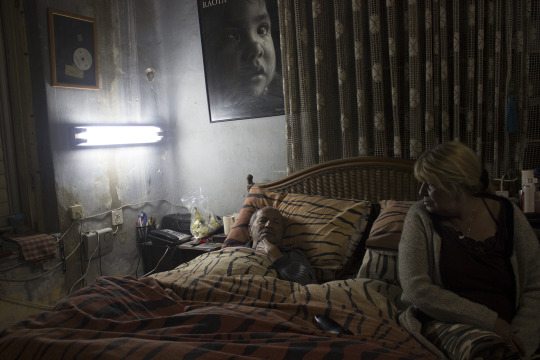
My great-uncle Moshe Meshumar. He was part of the Shubelim band, one of the earliest players in the formation of Mizrahit music, a genre that combined electric guitars with Arabic, Turkish, Greek and Yemenite elements sung in Hebrew. Shabazi, Tel Aviv, 2015.

Girls dressed up at a Moroccan henna ceremony. East Jerusalem, 2014.
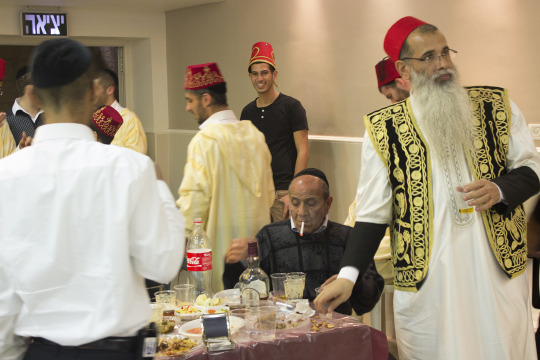
A Moroccan pre-wedding henna ceremony. East Jerusalem, 2014.

A bride wears the Tishbakh lulu (originally of the Sana'a region) and is accompanied to the hall for her pre-wedding za'afa, a ceremony comparable to the Moroccan henna. Binyamina, 2015.
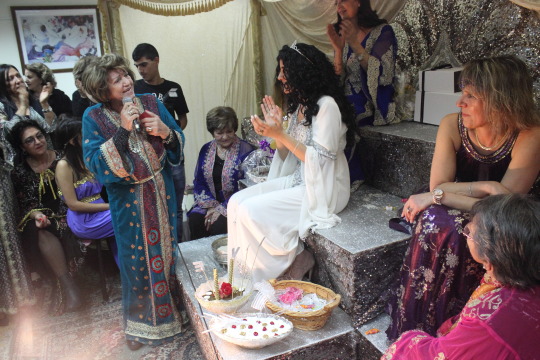
A bride's grandmother sings to her at a Persian henna celebration. Rishon Le Zion, 2015.

A photoshoot for a henna fashion magazine. Ramla, 2015.

Libyan Heritage Centre, Or Yehuda, 2015.

Or Yehuda, 2015.

Ohel Moshe Yemenite syangogue, Moshav Yinon, 2015.
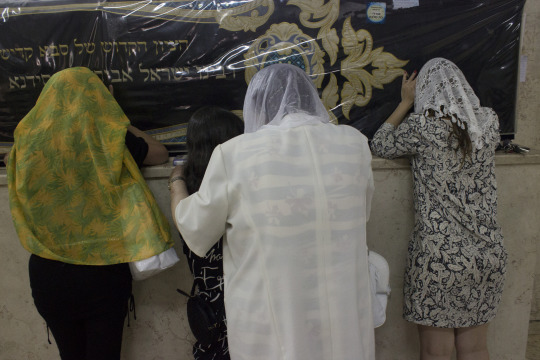
Women pray at the Baba Saleh Tomb. Netivot, 2016.
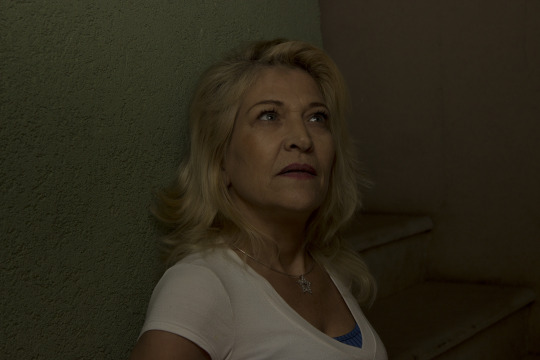
Beit Shemesh, 2014.
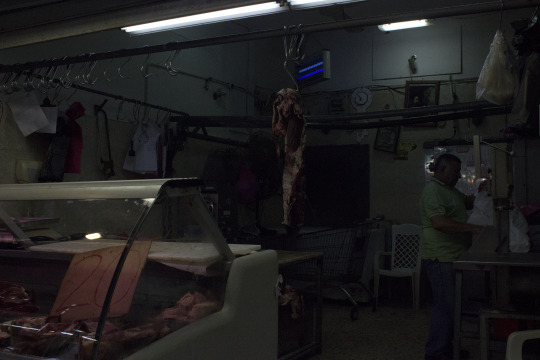
The shouk remains the domain of blue-collar Mizrahim and Palestinians. Carmel Market, Tel Aviv, 2015.
9 notes
·
View notes
Text
Aleks Slota [DE/PL]
Asphyxiating Anxiety
In the corridors of studio ALTA I will engage with my voice on the basic level of the intake and expulsion of air. Various breathing techniques will become the starting point of a sound and body performance exploring the trauma of panic attacks and social anxiety. I will investigate how different body shapes define the breath and thus how the breath defines the voice.
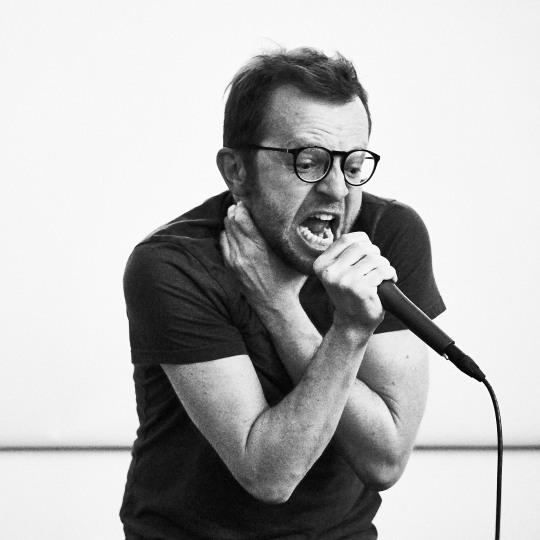
Aleks Slota (b. 1978, PL, based in Berlin, DE) is a multidisciplinary artist working primarily in the mediums of performance and sound art. Slota has presented performances in art venues and festivals such as: Galerie Thaddaeus Ropac (FR), Kunstquartier Bethanien (DE), SWAB art fair (SP), Tulsa Artist Fellowship (US), Musrara Mix (IL), Acción!MAD (ES), and Tempting Failure (GB) among others. https://www.aleksslota.com/ https://www.instagram.com/aleks_slota/ https://vimeo.com/aleksslota
0 notes
Photo

(via GIPHY) "Take the tangent", performance by Patrick Jambon at Musrara Mix Festival 19, Jerusalem, Israel, 2019, pictures by Tali Katzurin.
0 notes
Text
Musrara Mix Festival: Displaced in Musrara
Musrara Mix Festival: Displaced in Musrara
Jerusalem Post – González will be in town next week, along with fellow Spaniard Marte Roel, to participate in this year’s Musrara Mix Festival, which takes place from May 28-30. Source: New feed
View On WordPress
0 notes
Video
vimeo
Anyu - or how Stálin lost his nose from Sticky Frames on Vimeo.
Sticky frames present: Anyu - or how Stálin lost his nose by Lina Walde ; 7 min ; 2016 Festivals: ITFS Stuttgart (competition:young animation), Arica Nativa 2017 Chile, Animated Arizona Film Festival, 33rd International Festival Sarajevo “Sarajevo Winter”, Buddha International Fimfestival, India , River Filmfestival Padua, Italy, Lichter Filmfest Frankfurt, Germany, Filmmor womens filmfestival Istanbul- Turkey, Akbank Shortfilmfest Istanbul -Turkey, Animfest Athen, Greece, Students Filmfestival Grenoble-France, Chatrapati Shivaji- India, Artfools-Filmfestival-Greece, Womens Filmfestival Assuan-Egypt 2016 : Sweet as Film Festival- Canada, Stadtlichter Berlin- Germany, Dokumentar- und Videofilmfestival, Kassel - Germany, Rencontre Internationale de Wissembourg - France, Festival Tracce cinematografiche Film Fest, Roma- Italy, Chouftouhonna minority Festival, Tunis, Tunisia, Musrara Mix Festival, Goethe Institut Algier, Jerusalem- Shorts - Offenburg 2016 //
Awards: Shorts Offenburg 2016 - price for best the best animation movie
DVD-compilations: German Shorts 2017 - (German Films) New German Animation 2016 ( AG Kurzfilm )
Synopsis:
Anyu (mother) A long time ago in eastern europe the turmoil following a revolt against soviet occupation leads to the separation of a small child and her mother. While the mother is forced to flee the country, her daughter is raised by a bunch of precocious geese. After 5 years of separation the child get ́s on its way to meet the mother in the exile to stand face to face to her like a stranger. Anyu, which means mother in hungarian, is a story about the inner life of a refugee child. Anyu is also a story about a mother and her dichotomy between the societal role deemed as responsible for reproduction work and the willingness to avouch for freedom and taking part in a revolt.
0 notes
Text
Francisco Lopez talk at Musrara Mix Festival 23, Jerusalem. Part 1
www.franciscolopez.net/ t-hs.bandcamp.com/
0 notes
Text
[Aleks Slota] [PL]
Today's Specials
The performance will consist of a large poster hanging in the Prague venue with a list of possible actions. Audience members will be able to text the number of a desired action to the artist, who will then execute it in Berlin. The photo or video documentation recorded on a phone will be sent to the person requesting the action.
-----------------------------------------------------------------------------------------------------------
Aleks Slota (b. 1978, PL, lives and works in Berlin, DE) is a multidisciplinary artist working primarily in the mediums of performance and sound art. Slota has presented performances in art venues and festivals such as: Galerie Thaddaeus Ropac (FR), Kunstquartier Bethanien (DE), SWAB art fair (SP), Tulsa Artist Fellowship (US), Musrara Mix (IL), Acción! MAD (ES), and Tempting Failure (GB) among others.
[web]
[instagram]
[facebook]

[photo: artist's archive]
0 notes